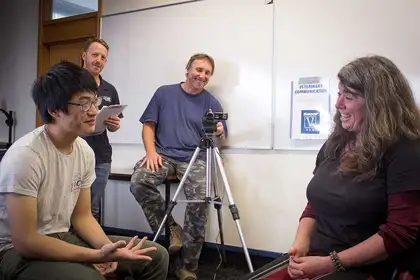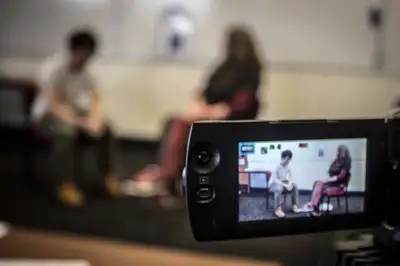
Fourth-year student, Ricky Lau, sits with his simulated client, farmer Oswald Osbourne, while facilitators Ryan Carr and Stuart Gordon look on.
A new training tool is being employed by Massey University to address a need for greater emphasis on high-quality vet-client communication in undergraduate veterinary training.
Fourth-year Bachelor of Veterinary Science undergraduates participated in the third phase of their Veterinary Clinical Communication Skills Training with live simulated consultations this week.
The training, in its second year, is based on the Calgary-Cambridge Guides developed in the health sciences in Canada and the United Kingdom. It starts with the introduction of key communication concepts and culminates with a graded-live assessment during their final year.
The training uses actors playing simulated clients, and requires the students to role-play scenarios designed to expose them to a variety of different types of veterinary consultations. It is undertaken by the Institute of Veterinary, Animal and Biomedical Sciences (IVABS), in collaboration with Shoof International, an agricultural and veterinary manufacturing, marketing and import/export supply company.
Veterinary Professional Studies Coordinator, Stuart Gordon, says that good communication skills in veterinary graduates are now an essential pre-requisite to entering the veterinary profession.
“When people think of the veterinary industry they think animals, but people often overlook the considerable human aspect to the industry and the skills needed to communicate effectively. When I went to veterinary school there was no recognition of how you needed to interact with the client, as it was all about the animal, but communication is an essential skill, just like any other clinical skill.”
“We are running this training, because this accepted oversight had not been reflected in mainstream undergraduate veterinary training. These communication skills are also better taught using simulated consultations with actors playing clients, rather than teaching the skills in a traditional lecture format.”
Stuart also emphasised that “Shoof’s involvement demonstrated the great importance the veterinary industry places on the development of excellent communication skills in undergraduate veterinary students – and we could not undertake this training without their support”.

Simulated interview.
How it works
The framework and concepts of communication skills are introduced in the students’ first year of lectures. These are: appropriate non-verbal language, use of open ended questions, demonstration of reflective listening and the expression of empathy. During their second year of study, the students also role-play with actors playing clients but are only required to initialise a consultation and gather information from the simulated client.
In their fourth year, students are required to explain their clinical findings to the simulated client and plan future treatment and management options. They do this using a ‘chunk and check’ method, which involves students breaking up their information into small chunks and checking with the client that they understand what they have been told. The consultations are again filmed and the simulated client does their best to test the student’s communication skills by saying unexpected things and challenging them with emotional outbursts. This simulates what often happens in a vet-client interaction during a real-life consultation.
Feedback is provided to the students by the facilitator “pausing” the consultation at crucial points and discussing what has been done well or what could be done better. After the consultation, the other students also provide constructive feedback to the trainee student as do the actors.
In the students’ final year, they are again assessed in their communication skills, but this time in a clinical setting within the Veterinary Teaching Hospital with real clients.